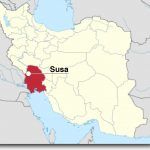[aesop_content color=”#FFFFFF” background=”#c39797″ width=”content” component_width=”700px” height=”auto” columns=”1″ position=”none” innerposition=”10px, 10px, 10px, 10px” imgrepeat=”no-repeat” floaterposition=”left” floaterdirection=”up” revealfx=”off” overlay_revealfx=”off”]Earlier this month, the ancient city of Yazd became the 22nd site in Iran to be inscribed by UNESCO on its World Heritage List, which distinguishes places deemed “of outstanding value to humanity.” To mark the event, Kayhan Life presents the second of three other prominent Iranian sites on the list.
[/aesop_content]
In 2015, Susa (the modern-day city of Shush) was added to the UNESCO World Heritage List. It is one of the oldest continuously inhabited cities in the world, with excavations uncovering evidence of continual habitation dating back to 4200 B.C. According to UNESCO, Susa contains 27 layers of superimposed urban settlements in continuous succession from the late 5th millennium B.C. until the 13th century A.D., bearing exceptional testimony to the Elamite, Persian and Parthian cultural traditions.

Located in Iran’s southwestern Khuzestan province – in the lower Zagros Mountains, some 250 kilometers (160 miles) east of the Tigris River – Susa was the principal city of ancient Elam in the fourth millennium, and one of the capital cities of the Achaemenid Empire.
“Susa appears as the converging point of two great civilizations which reciprocally influenced each other: the Mesopotamian and the Iranian plateau civilizations,” UNESCO said in its citation.
“Susa’s long-lasting and prominent role in the region, either as the capital of the Elamites, or of the Achaemenid Empire, or as a strategic center sought by neighboring powers (e.g. Assyrian, Macedonian, Parthian, Sassanid) is witnessed by the abundant finds, of disparate provenance and of exceptional artistic or scientific interest, and by the administrative, religious, residential and palatial, as well as functional structures and traces of urban layout (e.g. the remains of the Haute Terrasse in the Acropolis, the Palace of Darius in the Apadana, the residential or production quarters, the Ardeshir Palace) that more than 150 years of archaeological investigations have revealed.”
Susa was completely destroyed by the Assyrian king Ashurbanipal between 645 B.C. and 640 B.C. to avenge the people of Mesopotamia for the perceived wrongs they had suffered at the hands of the Elamites. It was rebuilt and inhabited, only to be conquered by Cyrus the Great in 540 B.C. It was made the capital of the Persian Empire by Cambyses II before being rebuilt and expanded upon by Darius the Great, who favored it over his other residences.
A closer look at Darius the Great by El Cid Al-Moussawi
Alexander the Great conquered Susa in 331 B.C. During his reign, mass weddings known as the “weddings of Susa” were arranged by the Macedonian king, and celebrated in Susa in 324 B.C. In an attempt to symbolically unite the Persians and Macedonians, Alexander married his companions to daughters of Persian nobility, himself taking as brides two Achaemenid princesses, even though he was already married to Roxana.
The weddings were officiated in the Persian fashion and the couples were each given a dowry by Alexander. All other Macedonians who had previously married Persian women were also registered and were found to number more than 10,000. Alexander died a year later. After his death, all of his officers promptly divorced their Persian wives.
Following Alexander’s reign, Susa became a Greek city and one of the regional capitals of the Seleucid kings, who reinforced their presence in the region by bringing Greco-Macedonian settlers to the city. Marked by the influence of Hellenism introduced by these settlers, it preserved the institutions of a Greek city under the rule of the Parthian kings, until it was conquered and rebuilt by the Sasanians in 224 CE. It was devastated during the Islamic conquest of Persia in 638 A.D. but survived until 1218 A.D. when it was completely destroyed by the Turkic Mongols, after which it was abandoned.
A total of 70 excavation campaigns were carried out in Susa between 1850 and 1978. According to Encyclopedia Iranica, the city extended over 1 square kilometer, and was “completely redesigned under the Achaemenids into a residential city with palaces and a surrounding wall.” The area was again rebuilt during the reign of the Seleucids and the Parthians, then “remained without further interference up to the early Islamic period.”
Susa was also the setting of the biblical Book of Esther, the story of a Jewish orphan in Persia fostered by her uncle Mordecai. She was crowned queen of Xerxes the Great, and saved her people from genocide by thwarting a plan by the chief courtier, Haman the Agagite, who planned to exterminate the Jews of Persia. The Jews established the annual feast of Purim in memory of their deliverance. Purim is celebrated to this day by Jewish communities around the world with a day of feasting and rejoicing.
The Tomb of Daniel, the burial place of the biblical prophet Daniel – who lived in Susa during the 6th century B.C. – is also located within the modern-day city of Shush. A shrine capped by an unusual white cone and known as Shush-e Daniel is believed to be the tomb of the Prophet Daniel. It is revered by both the local Muslims and Jews, for whom it is one of two holy sites in Iran, together with the Tombs of Esther and Mordecai in Hamadan.
More about the ancient palace by Gordon Lawrence

